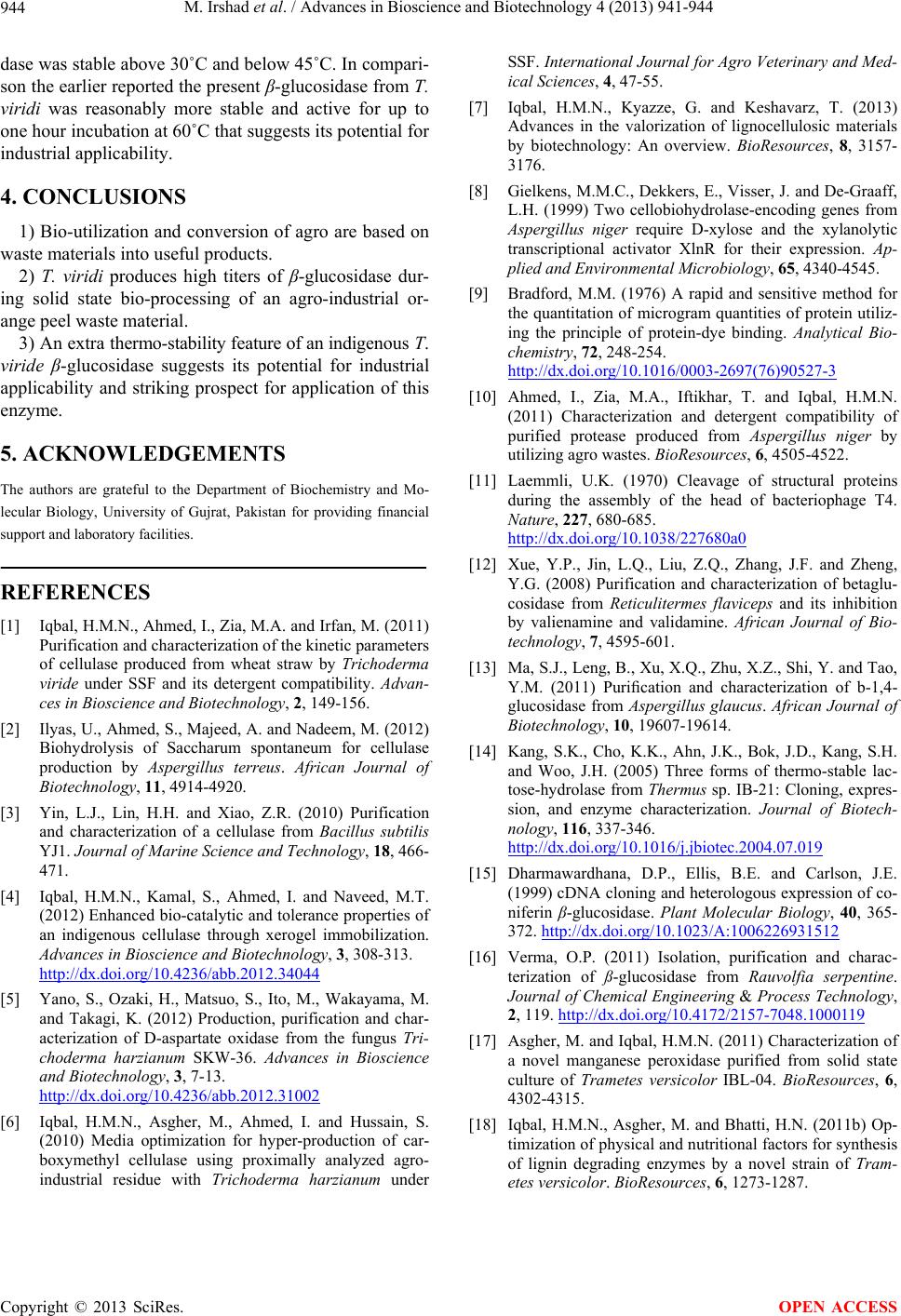
M. Irshad et al. / Advances in Bioscience and Biotechnology 4 (2013) 941-944
944
dase was stable above 30˚C and below 45˚C. In compari-
son the earlier reported the present β-glucosidase from T.
viridi was reasonably more stable and active for up to
one hour incubation at 60˚C that suggests its potential for
industrial applicability.
4. CONCLUSIONS
1) Bio-utilization and conversion of agro are based on
waste materials into useful products.
2) T. viridi produces high titers of β-glucosidase dur-
ing solid state bio-processing of an agro-industrial or-
ange peel waste material.
3) An extra thermo-stability feature of an indigenous T.
viride β-glucosidase suggests its potential for industrial
applicability and striking prospect for application of this
enzyme.
5. ACKNOWLEDGEMENTS
The authors are grateful to the Department of Biochemistry and Mo-
lecular Biology, University of Gujrat, Pakistan for providing financial
support and laboratory facilities.
REFERENCES
[1] Iqbal, H.M.N., Ahmed, I., Zia, M.A. and Irfan, M. (2011)
Purification and characterization of the kinetic parameters
of cellulase produced from wheat straw by Trichoderma
viride under SSF and its detergent compatibility. Advan-
ces in Bioscience and Biotechnology, 2, 149-156.
[2] Ilyas, U., Ahmed, S., Majeed, A. and Nadeem, M. (2012)
Biohydrolysis of Saccharum spontaneum for cellulase
production by Aspergillus terreus. African Journal of
Biotechnology, 11, 4914-4920.
[3] Yin, L.J., Lin, H.H. and Xiao, Z.R. (2010) Purification
and characterization of a cellulase from Bacillus subtilis
YJ1. Journal of Marine Science and Technology, 18, 466-
471.
[4] Iqbal, H.M.N., Kamal, S., Ahmed, I. and Naveed, M.T.
(2012) Enhanced bio-catalytic and tolerance properties of
an indigenous cellulase through xerogel immobilization.
Advances in Bioscience and Biotechnology, 3, 308-313.
http://dx.doi.org/10.4236/abb.2012.34044
[5] Yano, S., Ozaki, H., Matsuo, S., Ito, M., Wakayama, M.
and Takagi, K. (2012) Production, purification and char-
acterization of D-aspartate oxidase from the fungus Tri-
choderma harzianum SKW-36. Advances in Bioscience
and Biotechnology, 3, 7-13.
http://dx.doi.org/10.4236/abb.2012.31002
[6] Iqbal, H.M.N., Asgher, M., Ahmed, I. and Hussain, S.
(2010) Media optimization for hyper-production of car-
boxymethyl cellulase using proximally analyzed agro-
industrial residue with Trichoderma harzianum under
SSF. International Journal for Agro Veterinary and Med-
ical Sciences, 4, 47-55.
[7] Iqbal, H.M.N., Kyazze, G. and Keshavarz, T. (2013)
Advances in the valorization of lignocellulosic materials
by biotechnology: An overview. BioResources, 8, 3157-
3176.
[8] Gielkens, M.M.C., Dekkers, E., Visser, J. and De-Graaff,
L.H. (1999) Two cellobiohydrolase-encoding genes from
Aspergillus niger require D-xylose and the xylanolytic
transcriptional activator XlnR for their expression. Ap-
plied and Environmental Microbiology, 65, 4340-4545.
[9] Bradford, M.M. (1976) A rapid and sensitive method for
the quantitation of microgram quantities of protein utiliz-
ing the principle of protein-dye binding. Analytical Bio-
chemistry, 72, 248-254.
http://dx.doi.org/10.1016/0003-2697(76)90527-3
[10] Ahmed, I., Zia, M.A., Iftikhar, T. and Iqbal, H.M.N.
(2011) Characterization and detergent compatibility of
purified protease produced from Aspergillus niger by
utilizing agro wastes. BioResources, 6, 4505-4522.
[11] Laemmli, U.K. (1970) Cleavage of structural proteins
during the assembly of the head of bacteriophage T4.
Nature, 227, 680-685.
http://dx.doi.org/10.1038/227680a0
[12] Xue, Y.P., Jin, L.Q., Liu, Z.Q., Zhang, J.F. and Zheng,
Y.G. (2008) Purification and characterization of betaglu-
cosidase from Reticulitermes flaviceps and its inhibition
by valienamine and validamine. African Journal of Bio-
technology, 7, 4595-601.
[13] Ma, S.J., Leng, B., Xu, X.Q., Zhu, X.Z., Shi, Y. and Tao,
Y.M. (2011) Purification and characterization of b-1,4-
glucosidase from Aspergillus glaucus. African Journal of
Biotechnology, 10, 19607-19614.
[14] Kang, S.K., Cho, K.K., Ahn, J.K., Bok, J.D., Kang, S.H.
and Woo, J.H. (2005) Three forms of thermo-stable lac-
tose-hydrolase from Thermus sp. IB-21: Cloning, expres-
sion, and enzyme characterization. Journal of Biotech-
nology, 116, 337-346.
http://dx.doi.org/10.1016/j.jbiotec.2004.07.019
[15] Dharmawardhana, D.P., Ellis, B.E. and Carlson, J.E.
(1999) cDNA cloning and heterologous expression of co-
niferin β-glucosidase. Plant Molecular Biology, 40, 365-
372. http://dx.doi.org/10.1023/A:1006226931512
[16] Verma, O.P. (2011) Isolation, purification and charac-
terization of ß-glucosidase from Rauvolfia serpentine.
Journal of Chemical Engineering & Process Technology,
2, 119. http://dx.doi.org/10.4172/2157-7048.1000119
[17] Asgher, M. and Iqbal, H.M.N. (2011) Characterization of
a novel manganese peroxidase purified from solid state
culture of Trametes versicolor IBL-04. BioResources, 6,
4302-4315.
[18] Iqbal, H.M.N., Asgher, M. and Bhatti, H.N. (2011b) Op-
timization of physical and nutritional factors for synthesis
of lignin degrading enzymes by a novel strain of Tram-
etes versicolor. BioResources, 6, 1273-1287.
Copyright © 2013 SciRes. OPEN ACCESS